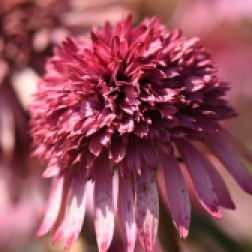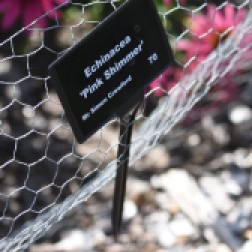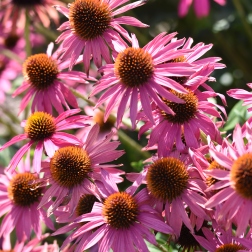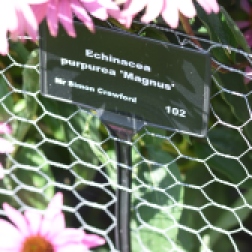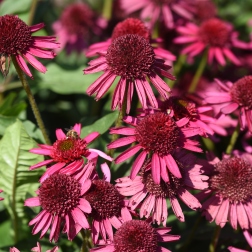
The Trial Fields are always a treat – proper scrutiny going on year in and year out with trials over several seasons to determine the qualities of new plants and the ongoing worthiness of older cultivars. I’ve been here throughout the past few years to look in detail at many of the trials – sweet peas, late-flowering Clematis, sunflowers, Agapanthus, Physocarpus, Delphiniums, Zantedeschia … there’s been rhubarb and Brussel sprouts, wild flower mixes, Dahlias and Chrysanthemums, all manner of bedding and so much more. There are a couple of links at the bottom for those who want to explore more.
I looked at these Echinacea last summer, and if I remember rightly it was another over-bright afternoon and I didn’t have a macro lens, so all I got was a lot of overexposure and a background of pale grey earth. This year I think I’m looking at them a month or so later – they are going over – but there is still much to admire and such a difference between varieties too. I haven’t photographed any of the poor specimens, stunted little things, sadly, that won’t make the cut. Some, however, are still a marvel and I will look out for them (if I had a sunny garden and a wide herbaceous border that is).
The point, though, of these trials is to see the plant through several seasons – over several years – how early and how late they perform, how they grow in the same conditions and how they compare. After such diverse weather this year – such a hot, hot and dry start to the Spring, late frosts and then wet, wet, wet and cool throughout July and August – it has been challenging. The good folk at the RHS though run these trials for three years (more?), so will be comparing performance with perhaps very different weather conditions in the other years before coming to any conclusions.
Award of Garden Merit (AGM)
The RHS Award of Garden Merit (AGM) helps gardeners choose the best plants for their garden
Plants that perform
You may well have seen the AGM logo (above). A cup symbol on a plant’s label shows that it has earned the AGM – it’s our seal of approval that the plant performs reliably in the garden.
Awards are usually given after a trial period at an RHS Garden, often Wisley, and are judged by our expert forums. RHS awards can also be given by ’round table assessment’. This is given when a forum of horticultural experts meet to debate the characteristics and garden performance of plants that the Society is unable to trial in one of the RHS gardens.
What is the AGM?
With more than 75,000 plants available in RHS Plant Finder alone, how can you tell which plants are best for all-round garden value? The AGM is intended to help gardeners make that choice, and is only awarded to plants that are:
- excellent for ordinary use in appropriate conditions (see RHS hardiness ratings)
- available
- of good constitution
- essentially stable in form and colour
- reasonably resistant to pests and diseases
Awarding the AGM
Awards are only made after assessment by an RHS forum of experts appointed by the Society to assess that particular trial. Each forum has its own area of expertise, and draws upon the experience of a wide range of experts, including nurserymen, specialist growers and well-known horticulturists. This assessment must then be ratified by the relevant Plant Committee. The trial and assessments usually take place at one of the four RHS Gardens but can also take place at one of our partner gardens, National Trust gardens or commercial nurseries.
What kind of plant is awarded the AGM?
Plants of all kinds can be considered for the AGM, including fruit and vegetables. The list currently includes more than 7,500 plants, but new awards are made each year to keep the award list as up to date as possible.
The AGM review
Unlike other RHS plant awards, the AGM is subject to regular review, to make sure that every plant still merits its place on the list. The first review took place in 2002: more than 1,300 plants that no longer met the AGM criteria lost the award, while 900 plants were added to the list. In the second review, in 2012, some 1,900 plants were removed from the list, and 1,600 were added. Since 2013, reviews have been conducted by each plant committee on a rolling review.
An Award of Garden Merit is a hard won accolade.
https://www.rhs.org.uk/Plants/Trials-Awards/Plant-trials
http://apps.rhs.org.uk/planttrials/index.asp

A couple of articles from The Telegraph, always a go-to place for excellent gardening advice, from Noel Kingsbury and Ursula Buchan – excellent authors in an already excellent resource…
How to grow echinacea, those lazy, crazy daisies of summer
Not known for its staying power, the seductive yet fickle echinacea inspires many experiments
These are mostly the result of crossing E. purpurea with other echinacea species. For those for whom the simple pink daisy of E. purpurea, with its slightly reflexed petals, does not offer enough excitement, there are lots of other colours: white, salmon-apricot shades, yellows, greens (yes, really); and different shapes: doubles, reflexed petals, petals with frills, fluffy central cones.
Like all daisies, echinaceas are composite flowers – that chunky central cone (which gives rise to the name “coneflower” in the US) is actually a mass of tiny fertile flowers, which bees and butterflies home in on to collect nectar. Those big showy “petals” are actually sterile flowers (technically “florets”) that advertise the flower to passing pollinators. Once fertilised, these outer florets fall off and the cone turns into a seedhead.
These stand well into the autumn, and make a nice contrast with wispy grasses, until the goldfinches bash them to bits to get the seeds out.
So echinaceas seem to have everything going for them. However, there is a “but”. Ask any group of gardeners to name a perennial that seems less than perennial, and echinaceas are nearly always there in the first five or so suspects. “Here one year, gone the next” is often the verdict. Why this is so is a bit of a mystery, especially since the plants look as though they ought to be fully perennial. Most true short-lived perennials have a distinct “neck” at the base of the plant where all the top growth joins the root system – there are no little shoots moving out with their own roots to make their way in the world. True perennials have these shoots from an early age. Echinaceas have them; it is possible to see, or feel, that at the base of the plant there is growth that wants to spread out and form a clump, albeit a tight one, as these plants do not spread freely. Next time you are at the garden centre, I suggest you try this – get your fingertips in at the base of some perennials in pots and see what you can feel.
Disappearing act
The best person to ask about echinaceas’ longevity has to be Neil Diboll, of Prairie Nursery, who has more than 30 years’ experience of growing prairie plants in Wisconsin. He tells me: “Echinacea purpurea is relatively short-lived, five to 10 years. Echinacea pallida and angustifolia, 10 to 20.” But five years is still an awful lot better than dying the first winter. So why do echinaceas often just disappear?
There is no question about their hardiness. Winters in their homeland, the American Midwest, reach well below -20C (-4F), the ground freezes down to a metre and the snow lies so deep that people lose their cars. So cold hardiness is clearly no problem. Many gardeners blame slugs and snails for mystery disappearances but, in fact, echinaceas are no more vulnerable than other perennials.
Cassian Schmidt, director of one of Europe’s leading perennial gardens, Hermannshof in Weinheim, Germany, told me: “They appear to be competition-intolerant; they grow well on their own, but suffer if other plants crowd them.”
“Rubbish,” says nurseryman Bob Brown, whose Cotswold Garden Flowers has one of the largest ranges of perennials in the country. “I grow my plants densely; they are E. purpurea Bressingham hybrids – a darker-than-normal strain – and, although I no longer have the 10 I originally planted, the survivors are in there, in their fourth year now, cheek by jowl with geraniums, hemerocallis and rudbeckia, all jostling for space.
“Part of the problem,” reckons Bob, “might be winter damp… a plant which habitually goes into a deep-freeze winter just goes dormant… warm and moist conditions encourage pathogens, so echinaceas might rot easily in our mild, wet winters.” This is as good an account as any, and helps explain why there is a definite correlation between the amount of yellow in the flower and the number of people mourning the loss of a plant the first spring after planting. The gene for the yellow flowered varieties of echinacea comes from E. paradoxa, a species from dry habitats. As is so often the case, the hybridist’s creation of new colours and forms comes at a cost – in this case, breeding in an Achilles heel in terms of long-term performance.
Making it work
So what are the best echinaceas to grow for longevity? “None of them,” snorts Bob. “If people want to grow them, they can grow them as annuals.” There are several easily obtained seed strains that do, in fact, flower the first year, offering most of the range in colour and form that is found in the named cultivars.
Billy Carruthers, of Edinburgh’s Binny Plants, is more positive: “We grow the straight Echinacea purpurea,” he says, rattling off a list of older varieties, all of them an improvement on the original species, but not sacrificing what staying power it has. He recommends ‘Rubinglow’; ‘Rubinstern’, which has ray florets held horizontally; and ‘Ruby Glow’, which has extra-big flowers, and is one of the few with an RHS Award of Garden Merit (itself an indicator that these are less than totally satisfactory garden plants). ‘Magnus’ is an older variety, again with bigger flowers than the species – it used to have an AGM, which is better than never having had one. A recent AGM winner is ‘Elton Knight’, bred by Anthony Brooks, the gardener at Elton Hall in Herefordshire – its multiple stems and long-flowering habit make for an exceptional performance.
Insider tips
At around 30-40in (80-100cm) in height, echinaceas are quite big plants. ‘Kim’s Knee High’ is useful in that it has lots of smaller flowers on a 25in (60cm)-high plant; ‘Kim’s Mop Head’ is similar in size, with white flowers. Kim Hawkes, who bred them, is a nurserywoman in North Carolina, and not one of those who Carruthers describes as: “getting it onto the market as quickly as you can, without trialling it first”.
Dutch breeder Marco van Noort subjects his plants to three winters before releasing them onto the market – a recommendation indeed! Among his plants is ‘Irresistible’, which has a central cone blown into a fluffy mass of tiny florets and salmon-toned outer ones.
‘Alba’ is a very pale green, almost white, old E. purpurea variety with a good record; the other day I was running a garden workshop and one of the students told me hers was seeding itself in her garden. Anthony Brooks, who holds the Plant Heritage national collection, also tells me they self-seed freely – perhaps having a wide gene pool encourages a higher rate of fertile seed being produced. Good news indeed, but rare; I suspect our autumns are too cold and soggy for the seed to ripen properly. Profuse self-seeding, by the way, is often a sign that a species is short-lived.
Other whites that Binny Carruthers rates are ‘Jade’ and ‘Green Edge’. One which Bob Brown says is “an improvement on many… because of the shapeliness of the plant”, is ‘Coconut Lime’, which has a rounded soft-textured cone.
The future will undoubtedly bring many more varieties. Most will be transient, and gardeners seeking truly perennial plants are probably best sticking to E. purpurea varieties and giving them good drainage. That cheerful daisy flower will no doubt continue to seduce us, however.
How to grow
Echinaceas need full sun and fertile, well-drained soil.
Avoid damp spots and heavy mulching over crowns in winter.
Deadhead to encourage flowering into the autumn after the main August-September season.
Once planted, they are best left alone — they do not transplant well.
E. purpurea and many hybrids flower the first year from seed. The elegant E. pallida is slower to establish but may be very long-lived.
Give yellow, orange and apricot hybrids extra-sharp drainage.
Sow seed as early as possible in the year, undercover, to allow for maximum growth; plants should be flowering by September — treat any that survive the winter as a bonus.
http://www.telegraph.co.uk/gardening/howtogrow/3312790/How-to-grow-echinacea.html
How to grow: echinacea
This pretty flower suits the formal border and the meadow look, writes Ursula Buchan
To most people, echinacea conjures up a herbal remedy for colds and ‘flu – a vital boost to the immune system or a piece of harmless quackery. For gardeners, however, Echinacea purpurea is a versatile herbaceous perennial with handsome, long-lasting flowers. It is sturdy and self-supporting, hardy, easy to grow, undemanding, suitable both for the formal border and the meadow look.
The present high standing of this North American prairie plant is partly due to its being an important element in “new naturalism” gardens. Amenable to being disposed in drifts and rivers, it is a striking sight en masse with its large daisy flowers, warm pink, purple-pink or ivory-white according to cultivar. These appear over a long period from early July to September and are followed by attractive, long-lasting seedheads.
The basal leaves are 6in to 8in long, lance-shaped, dark green and like sandpaper to the touch. Strong hairy stems about 3ft tall, sparsely scattered with leaves, carry broad (6in) composite flowers with purple-pink ray florets, which droop forlornly as they age. These surround prominent brown or orange-brown coned centres, consisting of masses of disc florets. Small wonder the common name is purple cone flower.
Echinacea purpurea makes an excellent cut flower, another reason for its popularity. There are several selected cultivars, four of which are widely available in nurseries; these differ from each other in flower colour and, to some extent, in height and flower size. The most famous is probably ‘Robert Bloom’, raised by Alan Bloom, the famous hardy perennial specialist, in 1955 and named after his son. He raised this because he didn’t think much of the cultivars then available, such as ‘The King’ and ‘Abendsonne’ (and they are no longer in the catalogues).
‘Robert Bloom’ has intense mauve-crimson flowers on 3ft stems, while the slightly shorter ‘Magnus’ is similar to the Echinacea purpurea in colour but has larger flowers (7in across) and ray florets that remain horizontal, a distinct advantage in my view. ‘Leuchstern’ (‘Bright Star’) grows to 30in and has purple-red flowers, while ‘Rubinglow’ is shorter still, with reddish flowers.
‘White Swan’ and ‘White Lustre’ have ivory-white flowers, the first with bonze discs, the second with yellower cones.
Popular introductions from America include the two dwarves (21in tall) ‘Kim’s Knee High’ (pink) and a white sport from it called ‘Kim’s Mop Head’.
Growing tips
To grow well echinaceas definitely like a meaty soil that drains sufficiently sharply so that it never becomes waterlogged in winter. They are also best in full sun, although they will tolerate some shade. It is important to mix a good quantity of compost with the soil from the hole before planting and to keep the plant well watered until established. After that, an annual spring mulch is all they need.
Dead-heading will encourage the formation of more flower buds; alternatively, the seedheads can be left for winter decoration. You will have to accept that echinaceas sometimes die for no very obvious reason, although winter wet is a possibility.
The coarse foliage seems to shrug off pest and disease attack.
Propagation
Sow seed in early spring (Chiltern Seeds has a good selection on offer). The plants will often flower in their first season. It is also possible to divide plants or to take root cuttings in spring.
Good companions
The combination in the flower of both bluish-pink and orange-brown makes it an excellent mixer, chiming satisfactorily with a range of other colours.
Echinaceas are obviously at home in a pink, purple, silver and blue scheme (let Verbena bonariensis seed itself close by, or plant echinaceas next to silver-leaved, blue-flowered Perovskia atriplicifolia). But it can also look very striking with Crocosmia ‘Solfatare’, which has yellow flowers and bronze foliage. Rudbeckias have the same flower shape (in fact echinaceas used to be included in the genus Rudbeckia) so R. occidentalis ‘Green Wizard’ or Rudbeckia fulgida var. deamii (for a really adventurous pairing) are also both worth considering. The white-flowered cultivars are easy to place in many schemes, since the whiteness is tinged with green.
Because of its sturdiness, Echinacea purpurea looks particularly good as contrast with plants that have more delicate or feathery foliage, such as the purple fennel Foeniculum vulgare ‘Purpureum’, the silver-leaved Artemisia ‘Powis Castle’ and decorative grasses including Deschampsia cespitosa ‘Goldschleier’ and ‘Bronzeschleier’.











































